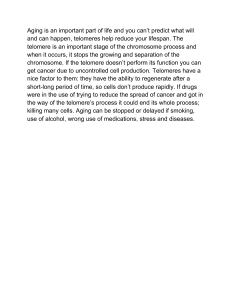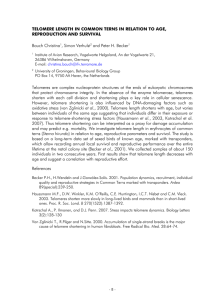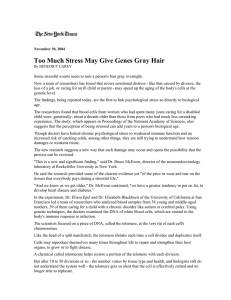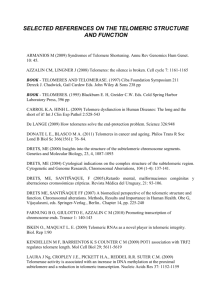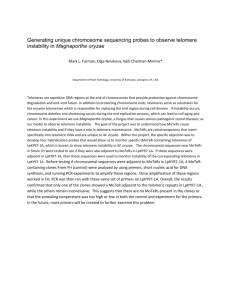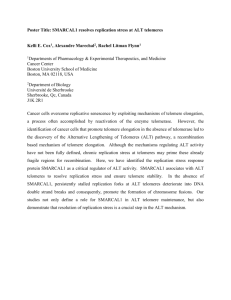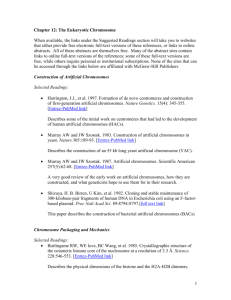Telomere length and cardiometabolic disease Dr Jess Buxton Prof. Steve Humphries
advertisement
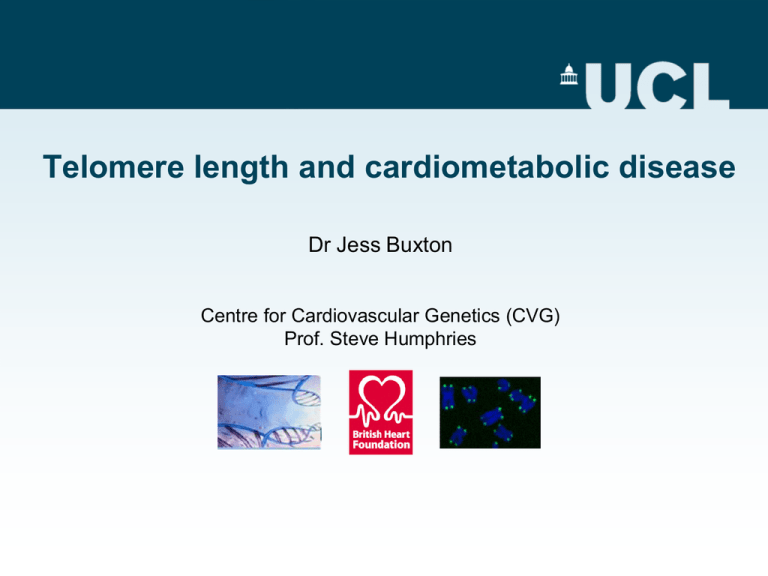
Telomere length and cardiometabolic disease Dr Jess Buxton Centre for Cardiovascular Genetics (CVG) Prof. Steve Humphries Overview of research in CVG group Complex disease/traits Identifying and characterising common genetic variants associated with CHD and related traits (blood lipids, atherosclerosis, type 2 diabetes) Monogenic disease Identifying gene mutations that cause familial hypercholesterolaemia (FH) Genetic contribution to heart disease Gene ontology Annotation of proteins and microRNAs, especially those involved in CVD pathways and processes Cellular mechanisms Investigating novel mechanisms underlying CVD - iron metabolism, micro RNAs Telomere shortening Vertebrate telomeres Armanios and Blackburn, Nature Reviews Genetics 13, p693-704 (2012) • Telomeres protect linear chromosomes from degradation and fusion • Consist of 1000’s of copies of (TTAGGG)n bound to shelterin protein complex • Shorten with every cell division (attenuated by telomerase enzyme in germ and stem cells) • Cells stop dividing when telomeres reach critically short length • Mean leukocyte telomere length (LTL) can be measured using qPCR Telomeres in health and disease Mean leukocyte telomere length (LTL) in adults shortens by approx. 20-40bp per year, due to inherent properties of linear DNA replication, exacerbated by oxidative stress + inflammation Shorter age-adjusted LTL is associated with increased risk of CHD, type 2 diabetes, insulin resistance, hypertension, stroke, …. Pooled relative risk for CHD is 1.54 (95% confidence intervals 1.30 to 1.83) comparing people with shortest versus longest third of LTL Mean LTL declines with age (N=1,632) R = 0.18, p= 3.4 x 10-13 From Haycock et al, BMJ 349:g4227 (2014). LTL and cardiometabolic disease risk: innocent bystander or prime suspect? Short telomere length (adjusted for age and gender) is a predictive biomarker for coronary artery disease and type 2 diabetes Evidence from genetic studies that telomere length plays a causal role in the onset of CAD – gene variants associated with longer TL are protective What are the potential underlying mechanisms? - Decline in circulating endothelial progenitor cell (EPC) numbers (CAD)? - Epigenetic changes (DNA methylation of subtelomeric regions)? - Chromatin conformation changes induced by short telomeres? Acknowledgements CVG group Collaborators UCL Aroon Hingorani Jon White Livia Carvalho Chris Power Marcus Pembrey Imperial College London Dylan Williams Alex Couto Alves Marjo-Riitta Jarvelin Alex Blakemore University of Oulu Leena Ala-Mursula Sylvain Sebert McGill University, Canada Matt Suderman Jane Pappas Moshe Szyf
